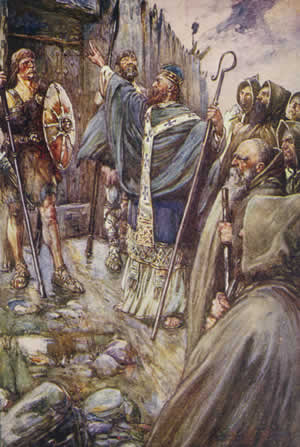 |
Saint Columba (7 December 521 - 9 June 597), sometimes
referred to as Columba of Iona, or, in Old Irish, as Colm
Cille or Columcille (meaning "Dove of the church") was the
outstanding figure among the Gaelic missionary monks who
some of his advocates claim, introduced Christianity to the
Kingdom of the Picts during the Early Medieval period.
In
563 he traveled to Scotland with twelve companions, where
according to his legend he first landed at the southern tip
of the Kintyre peninsula, near Southend.:) However, being
still in sight of his native land he moved further north up
the west coast of Scotland. In 563 he was granted land on
the island of Iona off the west coast of Scotland which
became the centre of his evangelizing mission to the Picts.
However, there is a sense in which he was not leaving his
native people, as the Irish Gaels had been colonizing the
west coast of Scotland for the previous couple of centuries.
Aside from the services he provided guiding the only
centre of literacy in the region, his reputation as a holy
man led to his role as a diplomat among the tribes; there
are also many stories of miracles which he performed during
his work to convert the Picts. He visited the pagan king
Bridei, king of Fortriu, at his base in Inverness, winning
the king's respect. He subsequently played a major role in
the politics of the country.
He was also very energetic in his evangelical work, and, in
addition to founding several churches in the Hebrides, he
worked to turn his monastery at Iona into a school for
missionaries. He was a renowned man of letters, having
written several hymns and being credited with having
transcribed 300 books. One of the few, if not the only,
times he left Scotland after his arrival was toward the end
of his life, when he returned to Ireland to found the
monastery at Durrow. He died on Iona and was buried in the
abbey he created.
|

